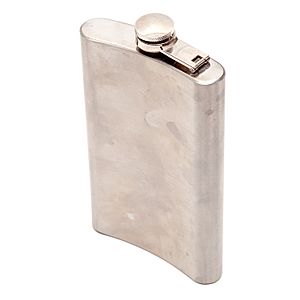Hip flask facts for kids
A hip flask is a special kind of bottle designed to carry drinks. It's usually thin and shaped to fit comfortably in a pocket, often against your hip or thigh. People use them to carry small amounts of beverages when they are out and about.
Contents
What is a Hip Flask?
Hip flasks have been made from different materials over time. Long ago, they were often crafted from materials like pewter, silver, or even glass. Today, most hip flasks are made from strong and shiny stainless steel. Some modern flasks are even made from plastic.
How They Look and Work
Hip flasks come in various shapes, but many are curved. This special curve helps the flask fit snugly against a person's hip or thigh. This design makes them comfortable to carry and easy to hide. Sometimes, this shape is called a "kidney flask."
Many flasks have a "captive top." This means the lid is attached to the flask with a small arm. This clever design stops the lid from getting lost when you take it off to drink.
Usually, you buy a hip flask empty and then fill it with your chosen drink. Some flasks even come with tiny cups, which makes it easier to share drinks with friends. However, most people drink directly from the flask itself.
The History of Hip Flasks
The hip flask, as we know it today, started to become popular in the 1700s. At first, they were mostly used by wealthy people.
However, simpler versions of portable containers for drinks have been around for much longer. For example, in the Middle Ages, people sometimes used hollowed-out fruits to carry their drinks.
During the 1920s in America, there was a time called Prohibition. During this period, it was against the law to make, sell, or transport certain alcoholic drinks. Because of this, some places, like the state of Indiana, even banned the sale of items like cocktail shakers and hip flasks.
Today, old hip flasks, especially those made of silver, are popular items for collectors. People enjoy finding and owning these historical pieces.
Carrying a Hip Flask: Rules and Laws
The rules for carrying hip flasks can be different depending on where you are.
In many parts of the United States, there are laws about carrying open containers of drinks in public places. This means that if a hip flask contains certain drinks and is open, it might not be allowed in public, whether you are carrying it or if it's in a car.
However, in the United Kingdom, the rules are different. It is generally not against the law to carry a hip flask or to drink from it in public places.
See also
 In Spanish: Petaca para niños
In Spanish: Petaca para niños




